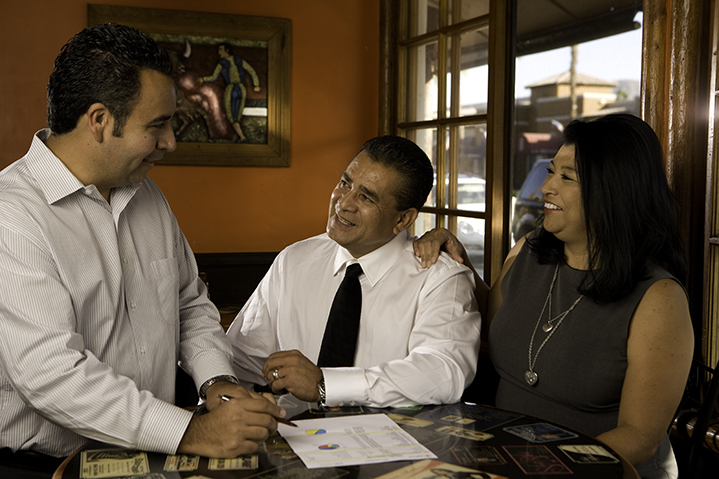Pedro Rincon, CPA, CVA with Armando & Martha Alvarez of Armando’s Bar & Grill in Palm Desert
The American Rescue Plan Act of 2021 includes, among other things, funding of a $28.6 billion Restaurant Revitalization Fund (the “RRF”). The RRF will provide grants (“RRF Grants”) to eligible restaurants to help offset revenue losses. Additional details and further guidance are expected to be provided by the Small Business Administration (SBA). The following is a brief summary of the main provisions relating to the RRF.
Who is Eligible for RRF Grants?
Subject to the disqualifications set forth below, a business is eligible for a RRF grant if it is a restaurant, food stand, food truck, food cart, caterer, saloon, inn, tavern, bar, lounge, brewpub, tasting room, taproom, licensed facility or premise of a beverage alcohol producer where the public may taste, sample, or purchase products, or other similar place of business in which the public or patrons assemble for the primary purpose of being served food or drink.
A business will be deemed disqualified from obtaining an RRF Grant if it:
- Is operated by a state or local government;
- As of March 13, 2020, owns or operates (together with any “Affiliated Business”) more than 20 locations, regardless of whether those locations do business under the same or multiple names;
- Has a pending application for or has received a grant under SBA’s Shuttered Venue Operators Grant Program; or
- Is majority-owned or controlled by a publicly traded company.
For purposes of determining eligibility, an “affiliated business” is a business in which an eligible entity has an equity of not less than 50 percent, or in which an eligible entity has the contractual authority to control the direction of the business – provided that such affiliation shall be determined as of any arrangements or agreements in existence as of March 13, 2020.
How Much Can an RRF Grant Recipient Receive?
A business that is eligible for an RRF Grant may receive an amount equal to its “pandemic-related revenue loss,” subject to a cap of $5,000,000 per physical location and an aggregate cap of $10,000,000 on RRF Grants to it and its Affiliated Businesses.
An eligible entity’s ‘‘pandemic-related revenue loss” means:
- For most, 2019 gross receipts minus 2020 gross receipts;
- For an eligible entity that was not in operation for all of 2019, (a) 12 times its average monthly gross receipts in 2019, minus (b) 12 times its average monthly gross receipts in 2020;
- For an eligible entity that opened between January 1, 2020, and March 10, 2021 (unless and until SBA establishes another formula), (a) its payroll costs (generally as defined for PPP) minus (b) its gross receipts; or
- For an eligible entity that has not yet opened as of the date of application for an RRF Grant but has incurred payroll costs (generally as defined for PPP) as of March 10, 2021 (unless and until SBA establishes another formula) the amount of those expenses.
In determining the amount of the RRF Grants, pandemic-related revenue losses for an eligible entity are reduced by any amounts received from First Draw PPP Loans and Second Draw PPP Loans.
For example, a restaurant that earned $1 million in 2019 and $600,000 in 2020, and that also received a $100,000 PPP loan, would be eligible for a $300,000 RRF grant. Economic Injury Disaster Loans (EIDL) aren’t deducted from RRF grant amounts.
Is There Priority in Awarding RRF Grants?
Yes – during the initial 21-day period, applications from eligible businesses owned and controlled by women, veterans, or socially- and economically-disadvantaged individuals will receive priority. For purposes of establishing priority, an applicant shall submit a self-certification of eligibility for priority with the grant application.
In addition, for the first 60 days after enactment – as part of the program – $5 billion in funding will also be reserved for the smallest independent restaurants, which before COVID-19 earned $500,000 or less in a year, so that bigger establishments don’t consume the funds. Afterwards, the remaining funds will be open to any eligible entity regardless of the annual gross receipts.
How Can RRF Grant Proceeds Be Used?
In general, the funds cover a wide array of costs incurred during the pandemic, including outdoor dining construction expenses, spending on personal protection equipment, as well as cleaning and sanitization from February 15, 2020 to December 31, 2021.
Eligible expenses include:
- Payroll costs;
- Mortgage payments;
- Rent;
- Utilities;
- Outdoor dining construction costs;
- Personal Protective Equipment;
- Food and beverage costs;
- Supplier costs;
- Operational expenses;
- Paid sick leave;
- Other operational costs deemed to be essential to operations.
If a business that receives an RRF Grant fails to use all grant funds for allowable expenses set forth above or permanently ceases operations on or before December 31, 2021, it must return any funds that were not used for the allowable expenses.
I Am Eligible! When, Where and How Do I Apply?
As the fund has been quickly established, the SBA must still design rules and regulations detailing how businesses can apply. The program has not yet opened for applications, and the agency has yet to release a timeline for when it will begin accepting and processing requests for funds.
In the meantime, business owners can register for a Data Universal Numbering System (DUNS) number, a nine-digit identifier (assigned to companies by Dun & Bradstreet) that is like a “fingerprint” for businesses. A DUNS number is required to receive grants from the government.
You must also register with the U.S. government’s System for Award Management at SAM.gov in order to receive payments.
Pedro Rincon is a certified public accountant and certified valuation analyst with Osborne Rincon, CPAs. He can be reached at (760)777-9805 or princon@osbornerincon.com. Osborne Rincon is one of the oldest and most respected full-service accounting firms in the Coachella Valley. To learn more, go to www.OsborneRincon.com




